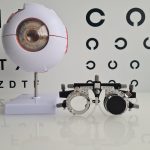Understanding Your Vision Prescription: A Clearer Look at the Numbers
Ever wondered what the symbols and numbers on your eyeglass prescription meant? Your eye doctor will be able to communicate effectively with you when you understand your vision prescription, and you will be able to make informed decisions about your eye care. Let’s make sense of this often-confusing document. Here are some things you need to know.

What Are The Key Players Here
- OD and OS: These abbreviations stand for “Oculus Dexter” (right eye) and “Oculus Sinister” (left eye). Each section displays values specific to that eye.
- Sphere (SPH): This value indicates the lens power needed to correct nearsightedness (negative number) or farsightedness (positive number). The further from zero the number is, the stronger the correction needed.
- Cylinder (CYL): This value measures astigmatism, an irregularity in the cornea that causes blurred vision at any distance. It’s blank if you don’t have astigmatism.
- Axis: This number applies only if you have astigmatism and specifies the orientation of the cylindrical lens correction.
- Add (ADD): In progressive or bifocal lenses, this value indicates how much extra power is needed for near vision.
- Pupillary Distance (PD): This measurement represents the distance between your pupils and is crucial for lens positioning.

When We Put It All Together
OD: SPH -2.00, CYL +0.50, Axis 180, ADD +1.00, PD 62mm
This individual is nearsighted (-2.00 in SPH) and has astigmatism (+0.50 in CYL) oriented at 180 degrees. They also need additional power for near vision (+1.00 in ADD), likely indicating bifocal or progressive lenses. Their pupillary distance is 62mm.
Looking Beyond the Numbers
The following things should still be kept in mind, even though understanding the numbers is helpful:
- Consult your eye doctor: They can explain your specific prescription, answer questions, and address any concerns.
- Consider lens options: Discuss different lens materials, coatings, and features with your doctor based on your needs and lifestyle.
- Regular checkups are crucial: Your vision can change over time, so schedule regular eye exams to maintain an accurate prescription.
By learning about your vision prescription, you become an active participant in your eye care journey. To ensure clear, comfortable vision for a lifetime, ask questions, discuss options, and schedule regular checkups. Knowledge is indeed power, and in this case, it’s the power to see clearly!
If you have any questions about how your eyes can benefit from the suggestions above, or if you have concerns about your eyes, feel free to call our office with any additional questions regarding your situation.
Thank you for choosing Fillmore Eye Clinic!
Call our office at:
1-800-323-4764




